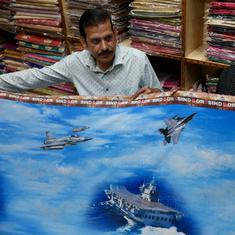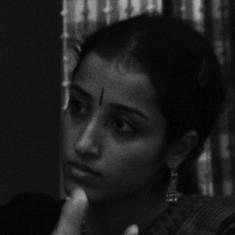Once gathered, pilgrims move en masse around the city and its environs progressing from one sacred site to another. This particular tide was to take them from Muzdalifah, where they had spent a night under the stars, to Mina, some three miles away, where they would symbolically humiliate Satan by casting stones at three pillars of rock. But like some powerful bore attempting to force its way up a narrow channel, the onrush had backed up, a white-crested wave as yet unable to generate any hint of forward motion. From my vantage point it was not the fluid dynamics of this impasse that fascinated me. The jostling stasis before me was becoming as traditional as the pilgrim garb has always been. Frequent congestive interruptions are modernity’s answer to manoeuvring multitudes of people from place to place by the most up-to-date means. Already I found these hiatuses at odds with my exalted expectations and cherished ideas of the experience offered by this place at this time. Perhaps it was the detachment of ideal and reality that captured my mind. Perhaps it was something in the power of this place. As I surveyed the scene before me I was drawn through the myriad host to just one bus and just one face.
The bus was stuck in a colossal traffic jam. Through one of its windows, I saw one pilgrim sitting perfectly still. A wrinkled face illumined by eyes whose resolute gaze was focused beyond the horizon. Mesmerized by that look, I transported myself through the hubbub as if floating timelessly towards this old man. As I inveigled my way through the crush I understood that he was aware of me, though his gaze had not shifted nor had he made any movement. Only when I got close to the bus did he move. With the deliberation of age and infinite effort he negotiated his way against the tide to leave the bus. It seemed to take for ever. I watched each tottering step until he stood before me. Face to face, I knew what had drawn me to this one old man. Serenity emanated, a blissful calm surrounded him. Without a word, he stretched out his hand and gave me the two pieces of bed linen he had been clutching. Instinctively I took hold of his bundle and followed. He led me beyond the crowds.
At a quiet spot beyond the roadway he indicated that I should lay his sheet upon the ground. It billowed like a sail in the morning breeze. When I had smoothed it out, he lowered his frail body onto it and settled himself down. As he lay there at rest he nodded to me and I understood his gratitude. I sat beside him – I don’t know for how long. We did not talk. There was nothing to say. And then I knew he had traversed the horizon. Gently, with reverence, I spread the second sheet to cover his body. Only then did I become concerned. What should I do next? What memorial, what procedure, who to tell, how to keep his body from being trampled by some sudden eddy of the crowd? I was left with questions. He had his answer, his final destination.
It was 16 December 1975. I was fulfilling one of the most important religious duties of a Muslim: Hajj, or pilgrimage, to the sacred city of Mecca. I was excited, enraptured, and somehow connected to over two million other pilgrims who were performing the Hajj. I hoped to return spiritually uplifted. Yet the old man had come to die. I felt that he understood the inner meaning of Hajj better than me.
Mecca, birthplace of Islam and also of the Prophet Muhammad, is Islam’s holiest city. It is a city that I, in common with almost all Muslims, have known all my life. A once-in-a-lifetime visit to Mecca is a key obligation. Most Muslims, however, will never see Mecca, and yet will have learned, perhaps even memorized, its geography from the moment they were taught to pray. The first lesson for any Muslim child preparing to pray is to identify the location of Mecca, and then to prostrate in the direction of the city, not once, but five times daily.
Our house in Dipalpur, Pakistan, where I was born and spent my infant years, had one tattered old calendar on the wall. In fact, it was very likely the only item of decoration in our house. The calendar had a picture – rather gaudy, I now realize – of the Sacred Mosque that stands at the heart of Mecca with its soaring minarets amid the encircling hills. The heart of the Mosque, the centre of the picture, was the Kaaba. The Kaaba drew the eye. It was an abrupt, arresting presence, a simple cuboid structure enveloped by a drapery of gold embroidered black cloth. If you peered intently at the picture you could just make out that the streams of white swirling around this focal point were a mass of pilgrims. The word ‘Allah’ was written in bold Arabic letters just above the minarets.
Time has moved on, but the image of the Kaaba on our decorative calendar is fixed, burnt into my memory. The very first picture I ever saw confirmed in me the certain knowledge that, while God is everywhere, in some special sense the divine power is focused in this one place; that the Kaaba is quite simply God’s House. This picture so clearly indicating God’s presence formed a primal bond that I knew connected me, inseparably, for all time to this one place. It was a childish innocence, and yet everything I learnt was to strengthen this conviction. It grew up within me as I added new layers of understanding. This sense of personal attachment is not mine alone. It is a love and devotion, a yearning and a dream that I share with more than a billion others. It is a common bond between Muslims: Mecca and I is at one and the same time Mecca for all. To be at Mecca is the taproot of individual identity and the common link of an entire worldwide community.
My first religious lessons were all about Mecca. When my mother taught me to read the Qur’an as an infant, I learned that the Sacred Text of Islam was God’s Words first revealed to Muhammad at Mecca. The stories I was told about the life of the Prophet Muhammad made Mecca and its environs more familiar to me than the country in which I lived: the cave at Hira, on the outskirts of Mecca, where the Prophet received his first revelations in 611; the town of Medina, which was called Yathrib during the days of Muhammad, where the Prophet sought refuge from persecution in Mecca; and the well of Badr and the mountain of Uhad where the Prophet fought his battles. But in Islamic tradition the history of Mecca long pre-dates the seventh century. The holy precincts around the Kaaba contain stories stretching back to the very beginning of time. Adam, who in Muslim tradition is the first Prophet, visited Mecca and was buried there. Prophet Ibrahim, or Abraham, the father of monotheistic faiths, built the Kaaba with his son Ismail, or Ishmael.
Every Muslim child grows up with these stories, internalizing their geography as a personal landscape whose contours and history define who they are.
But Mecca is so much more than a place where things happened once upon a time in history. Mecca matters because, as my mother often explained, it was there that God revealed to the Prophet Muhammad his guidance on how to lead a moral life. So what the Prophet taught, what he said and how he did things provided the examples that I was told I should try hard to follow in order to grow up to be a fine human being. What happened in Mecca was alive in the simplest daily activities of my life, in all the strictures with which adults seek to tame youthful exuberance and the knotty deliberations that a gregarious youngster like me encountered in determining whether I was being naughty or not so nice. There was never a doubt that I must always look towards Mecca if I was to amount to anything worthwhile in this world.
Excerpted with permission from Mecca: The Sacred City by Ziauddin Sardar, published by Bloomsbury India, Rs 599.










